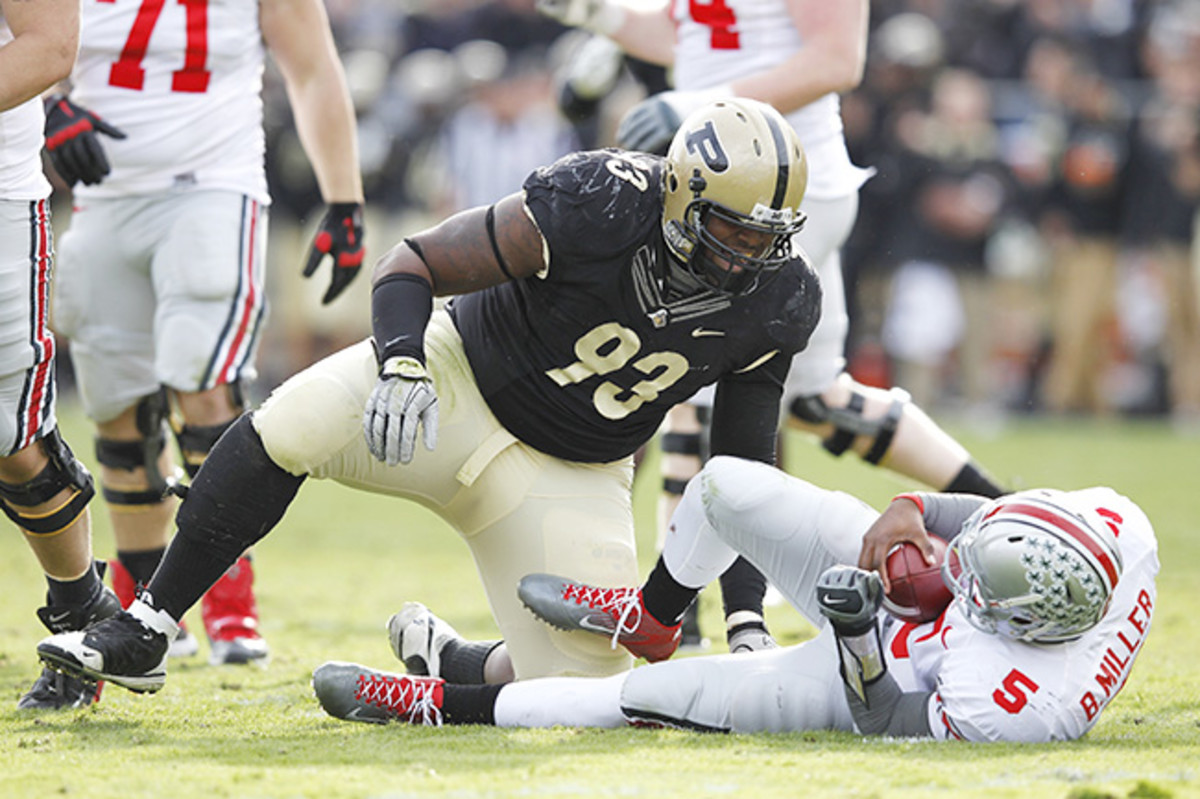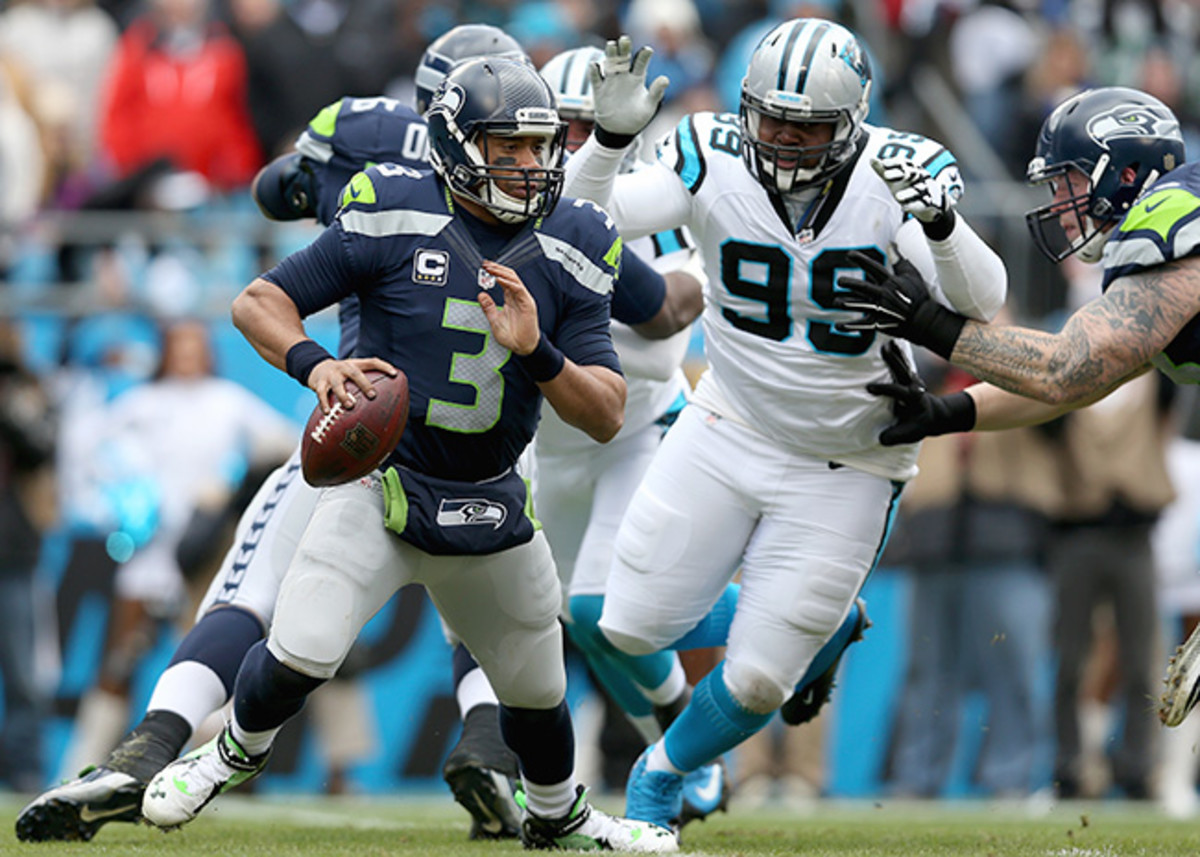The Short Path to Stardom

SAN JOSE, Calif. — For the past few days, Kawann Short hasn’t been able to sleep. Since the Panthers got to California, he’s tossed and turned, and yesterday morning was no different. There he was, at 5 a.m., upright in his bed at the San Jose Marriott, glancing at the clock every few minutes. Carolina’s meetings wouldn’t start for another two and a half hours.
Rather than chase a bit more sleep, Short brushed his teeth and made his way downstairs just after 6. The full breakfast spread wouldn’t be out for another half hour, so he grabbed a notebook and what little fruit he saw and ducked into the makeshift meeting rooms the Panthers are using this week. That’s where defensive line coach Eric Washington found him, alone, poring over film. “With all the free time available to these guys, he’s still focused on trying to play at his absolute best,” Washington says.
It was a scenario that probably wouldn’t have played out before this season. As most young players do, Short spent his first two years scrambling to find footing in the NFL. The real change came last offseason, when Short realized he was taking on a full-time role as a starter. “I was just paying attention to detail,” Short says. “Studying more, watching film more, and actually asking, instead of assuming. Asking coaches what I needed to work on, how I needed to do it, when I needed to it, and what type of atmosphere I could do it in.”
The result was an explosion of production in 2015. Short went from five sacks combined over his first two seasons to an eye-popping 11 this year. He’s transformed from a player who flashed across the screen once a game to a surefire Pro Bowler. As the Panthers prepare for their second Super Bowl ever, Short has emerged as a driving force behind the league’s best team.
* * *
E’Twaun Moore met Kawann Short when he was 5 years old. The pair lived around the corner from one another in East Chicago, Ind., and each day they’d make the short walk to Eugene Field Elementary together. The only football Moore ever played was pickup on a field cattycorner from their homes. Basketball was their shared connection. They played on teams together all the way through high school, when both were starters for a powerhouse East Chicago Central team. Moore, the point guard, was the star, but Short, as an undersized 6-3 power forward, did his part.
“He had really good footwork—up and under, drop step moves,” Moore says. “He was really quick on his feet when he caught the ball in the post, so he could score, easy. I think he averaged 15 and 10 with us.”
The Cardinals advanced to the Class 4A state championship game during Short’s junior season, and against a North Central team featuring high school phenom and current Pelicans guard Eric Gordon, Short poured in 20 points and 10 rebounds in an 87-83 win.
The friends would both go on to Purdue. Moore continued to star on the court—he now plays for the Chicago Bulls. Though only lightly recruited in football, Short’s future was on the gridiron.
Gary Emanuel was hired as Purdue’s defensive line coach after Short’s first season in West Lafayette, and as the legend went, 315-pound Short was such a ridiculous athlete that he could 360 dunk a basketball. “I could never do a 360,” Short says now, laughing. “But I appreciate the compliment. Shout out to Coach Emanuel.” Short can still throw down, though. As he’s gotten stronger, he says, it’s easier than ever.
“You talk about a kid who’s over 300-some pounds who can dunk a basketball, who can run up and down the court, that’s a hell of a skill set to bring to the football field,” Emanuel says.
As a Boilermaker, Short survived on that rare blend of size and quickness. His explosion was obvious, but what shocked Emanuel was the flexibility, Short’s ability to bend and twist his way around blockers on his way to the quarterback. He slithered his way to seven sacks as a senior while being named a second-team All- America, and when Washington got to Purdue to work Short out before the 2013 draft, he realized what he’d seen on film did little justice to the type of talent he was dealing with.
“I remember after I worked him out, I came back, and I talked to Sam Mills [III], who works with me with the defensive line,” says Washington. “I told him, ‘You know something, Sam? This guy is going to be better than his opponent before the ball is even snapped.’ That’s what we thought about his talent level. Without technique, without nuance, he’s just going to be better sometimes.”
* * *

The concern entering the ’13 draft, which Sean McDermott admits, was how hard Short played—and for how long. Stamina had been an issue at Purdue. Emanuel says the emphasis was often about reaching a point where Short could finish both plays and games. “Within that first year,” McDermott says, “Kawann took ownership of it.”
Short eventually went 44th overall, 30 picks after fellow defensive tackle Star Lotulelei. That 2013 draft was the final step for the reclamation project Carolina’s defense had become under Ron Rivera. The Panthers had jumped from 32nd in defensive DVOA in 2011 to 11th in 2012, Luke Kuechly’s rookie season. With the addition of Lotulelei and Short, the Panthers jumped all the way to third in 2013.
Rivera and general manager Dave Gettleman have coaxed contributions from a slew of aging, forgotten or never-even-realized talents all over the roster, but like any great team, they have found greatness through their draft picks. Short, Lotulelei, Kuechly, Josh Norman and Thomas Davis represent the five central pieces of Carolina’s defense. Each was drafted by the Panthers.
On draft day, one of the first calls Short received was from Lotulelei, who’d gotten his new teammate’s number from Washington. “We just clicked from there,” Short says. “We’d been texting, texting, texting, and when we got here, it was like we knew each other already.”
McDermott has a rough outline for how players have typically developed in the Panthers’ defense. As rookies—freshmen, as he says—it’s about acclimation, adjusting to the speed and the violence of a new level. “In our system,” Washington says, “you first have to know yourself really well.” The second season is about maintaining the progress made from Year 1.
“Sophomore to junior year, where he is now, that’s really where you expect to see [a jump],” McDermott says. “And that’s where we’ve seen it.” For the first time in his career Short entered the season as a starter. His playing-time percentage jumped from 58 percent of Carolina’s defensive snaps in 2014 to nearly 70 percent this season, and as Short could sense that increased role on the horizon, the pressure to consistently contribute only intensified. “I was a starter now, Short says. “Just to come in and work with these guys, and become a starter, think like a starter. I had to produce.”
* * *

A trade with the Bears brought Jared Allen to Carolina in late September. While most of the Panthers’ defense and staff had seen the previous iterations of Kawann Short—the ultra-talented, raw prospect still looking for a firm grasp on the mental side of the NFL—Allen saw a third-year pro who could see plays developing before they even happened. “What struck me is his ability to process information,” Allen says. “He processes information like a guy who’s been in the league a lot longer than he has. We’re in a reaction-based position—you’re going to see a block, and you’re going to react to it. He has the ability to process the block he’s getting and make the right reaction off it.”
For Short, the ability to diagnose plays was the final step. He still has the ability to blow passt slow-footed linemen at the snap of the ball (see the strip sack of Russell Wilson in the first quarter of this year’s divisional playoff), but many of his 11 sacks involved identifying the play and making a second move toward the quarterback. Three years ago, Short’s inability to sustain effort and finish plays pushed him to the second round. Now, his knack for sustaining and finishing has sent him to the Pro Bowl.
These days, any choice a guard makes against Short is probably going to be wrong. Guards who hop back off the snap to offset his speed get run over. Others who anchor down for the bull rush get whiplash as they watch him fly past. Anyone forced to deal with him alone is looking at a long afternoon. “We want to generate pressure with our front four, so you have to win on and one,” Washington says. “And he’s done that at a higher rate this year, even outside of the sack numbers.”
With the way offenses have trended in recent years, Sean McDermott says, generating pressure from interior defensive linemen is as important as ever. “Quarterbacks are getting the ball off so fast, you have to get penetration and affect the quarterback in the A or B gaps,” McDermott says. “Peyton Manning is no different this week.” With double-digit sacks, Short is that player for Carolina, but he isn’t built like some of the league’s other great penetrators. His wide frame makes him a key in the run game as well. For stretches this season, he moonlighted at nosetackle with Lotulelei on the bench, and at times, Washington even threw him at defensive end. “The more and more I watched him, the more and more I saw him play, I thought, ‘This kid is something,’” Jared Allen says.
For most of Allen’s career, as he was collecting 85.5 sacks during six seasons with the Vikings, he played alongside one of the scariest defensive tackle pairings in NFL history. Pat Williams was a 320-pound gap stuffer who made running the ball nearly impossible. Kevin Williams was the three-technique tackle any coach would build in a lab. They played off one another perfectly, like they were meant for each other. As he’s watched Short these past four months, that’s the type of future he imagines for the Panthers.
“Star and KK can definitely be that Williams Wall,” Allen says. “I loved to watch those guys, as a football fan, just to watch what they could do. Then to see that here with two young guys, hopefully they’ll have their whole careers together. It’s a special thing.”
